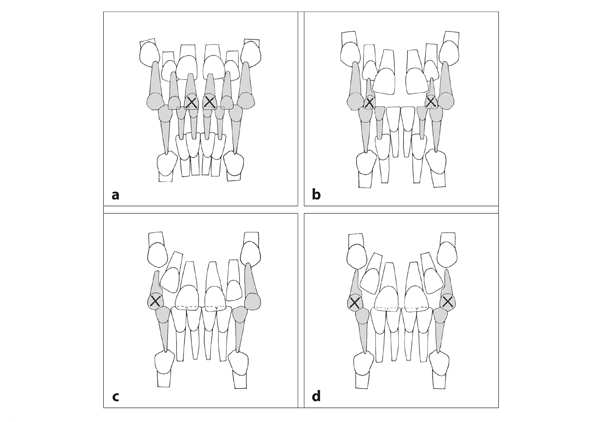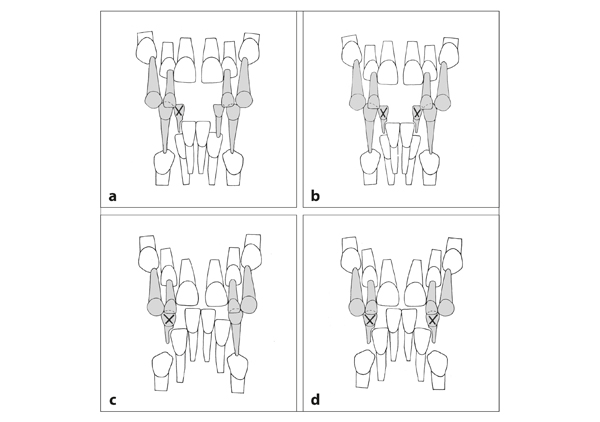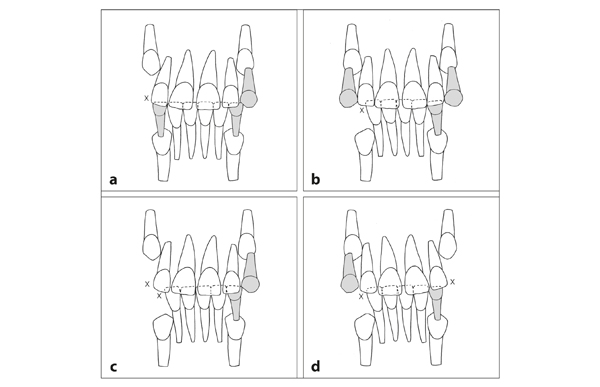CHAPTER 16
Premature Loss of Deciduous Teeth
Causes of Premature Loss of Deciduous Teeth
Deciduous teeth can be lost early because of premature resorption of their roots, trauma, or decay (caries) followed by extraction. Loss by premature resorption and trauma happens only in the anterior region. Untimely loss due to caries and extraction mainly affects the deciduous molars.
Premature resorption of the roots of deciduous incisors and canines is a symptom of crowding. In addition, the distal root of maxillary second deciduous molars can resorb prematurely if the first permanent molar erupts too far to the mesial. However, the deciduous molar will not exfoliate, and the eruption of the permanent molar will be blocked.1,2 Premature loss of deciduous molars can lead to migration of adjacent teeth and to shortage of space for their successors.
Premature loss of deciduous molars due to caries happens twice as often in the mandible as in the maxilla.3–7 Deciduous canines are somewhat resistant to decay, as are deciduous incisors, which are present in the mouth only a relatively short period of time. Decayed deciduous molars can lose part or all of their crowns. Complaints of pain are often the reason for their removal. Infections are an indication for extraction, especially because they can affect succeeding teeth. Deciduous teeth with a nonvital pulp can cause large, purulent periapical infections. In contrast with permanent teeth, no fibrous encapsulation of the abscess takes place in deciduous teeth. Hence, successors can be damaged, and abnormal shapes, hypocalcifications, and caries lesions can result.8–10
Effects of Premature Loss of Deciduous Teeth
The effects of premature loss of deciduous teeth are predictable and can be well estimated. The occurrence of migrations after premature loss of deciduous teeth depends on which tooth is lost as well as on the occlusion.3,11–14 These migrations are greater and happen more quickly in the maxilla than in the mandible.3,15,16 Furthermore, migrations in the maxilla are mainly limited to mesial movement and rotation of the first permanent molar. In the mandible, teeth mesial to the lost tooth have a greater tendency to move distally.15
In addition, the spatial conditions in the dental arches are important.12,17,18 In general, premature loss of deciduous teeth in dental arches with excess space has no or only little effect on the development of the dentition. In the absence of excess space, complications might appear; in cases of crowding, complications are a certainty.
Tongue and buccal musculature also play an essential role,3,5 and the timing of the loss is relevant.12,17 Loss long before the time of emergence of the successor leads to its delayed emergence; loss shortly before emergence has an accelerating effect.19 Moreover, loss of deciduous teeth at an early age has more negative sequelae than loss occurring later. Migrations of adjacent teeth take place mainly in the first 6 months after the premature loss.18
It is important to emphasize that the loss of space is often limited and of little relevance to the development of the dentition.11–14,20–22 In addition, in the mandible some of the lost space can be regained at the end of the second transitional period.23
Premature loss of deciduous incisors and canines
With little space in the anterior region, as in a deciduous dentition without diastemata, deciduous incisors and canines can be lost prematurely with the emergence of an adjacent permanent tooth (Fig 16-1). Trauma is usually the cause of premature loss of maxillary central deciduous incisors. If they are not pushed into the jaw, which can cause displacement and dilaceration of successors, but rather knocked out, the only effect will be delayed emergence of their successors.24 In addition, maxillary central deciduous incisors do not play a role in the mechanism of distal displacement of lateral deciduous incisors and deciduous canines during the eruption and emergence of the central permanent incisors (Fig 16-2a).
With the eruption and emergence of a maxillary central permanent incisor, the root of the adjacent lateral deciduous incisor can resorb, and the crown can exfoliate (Fig 16-2b). In unilateral premature loss of a maxillary lateral deciduous incisor, the deciduous canine on that side will not displace distally and buccally during the eruption of the central permanent incisor; in bilateral loss, this phenomenon will occur on both sides.
Fig 16-1 Premature loss of deciduous incisors and canines. (a and b) With crowding in the maxilla, the lateral deciduous incisors can be shed prematurely during the eruption of the central permanent incisors. (c and d) Too little space remains for the lateral permanent incisors. (e) Their eruption can lead to premature resorption and loss of the deciduous canines. (f) Subsequently, the lateral permanent incisors move labially and occupy their positions in the dental arch. Too little space remains for the permanent canines. Sometimes in such cases the deciduous canines are not lost prematurely; instead, the lateral permanent incisors emerge palatally (see Fig 15-18). See video clip 15.
In a comparable way, the eruption of maxillary lateral permanent incisors can lead to premature loss of deciduous canines (Figs 16-2c and 16-2d). If this happens only on one side, the incisors will migrate in that direction. Consequently, insufficient space remains there for the maxillary permanent canine, which will emerge buccally. If both deciduous canines are lost prematurely, both permanent canines will be outside the dental arch.
Fig 16-2 Effect of premature loss of deciduous anterior teeth. (a) Trauma of maxillary deciduous incisors can disturb the formation and eruption of their successors. Premature loss of central deciduous incisors in most cases has no effect on the development of the dentition. (b) In situations with severe crowding, the lateral deciduous incisors can be lost prematurely. Consequently, the displacement of the deciduous canines associated with the eruption of the central permanent incisors will not take place. (c) With unilateral premature loss of a maxillary deciduous canine, the incisors will migrate in that direction, and the midlines of the dental arches will no longer match. (d) With premature loss of both maxillary deciduous canines, the midline will not displace.
With asymmetry in location of formation and in eruption of permanent incisors, the premature loss can be unilateral (Figs 16-3a and 16-3c). This occurs more often than bilateral premature loss, particularly in the mandible (Figs 16-3b and 16-3d). Unilateral premature loss of deciduous canines leads to alterations in the angulation of the permanent incisors and to displacement of the midline of the dental arches (Fig 16-4).
Fig 16-3 Premature loss of mandibular lateral deciduous incisors and deciduous canines. (a) Unilateral loss of a mandibular lateral deciduous incisor as can happen with asymmetric positioning and eruption of mandibular central permanent incisors. (b) Bilateral loss of mandibular lateral deciduous incisors. (c) Unilateral loss of a mandibular deciduous canine, followed by migration of the incisors to that side and shifting of the midline. (d) Bilateral loss of mandibular deciduous canines, usually without deviation of the midline.
Fig 16-4 Effects of premature loss of deciduous canines on the angulation of permanent incisors and the position of the midline. (a) Unilateral loss of a maxillary deciduous canine results in tipping of the permanent incisors and shifting of the midline. (b) Unilateral loss of a mandibular deciduous canine has the same results. (c) Unilateral loss of opposing deciduous canines leads to tipping of the incisors in the same direction in both jaws. (d) With the loss of a deciduous canine in the mandible on one side and in the maxilla on the other side, the maxillary and mandibular permanent incisors will tip in opposite directions.
In the mandible, premature loss of deciduous incisors has consequences for the increase in intercanine distance. Furthermore, premature loss of mandibular deciduous canines can result in an increase in overjet and overbite.
Premature loss of deciduous molars
Undesirable migrations may or may not result from untimely loss of deciduous molars, and they are less likely to occur with the loss of first than second deciduous molars.11,13 With the loss of second deciduous molars, the migration is usually limited to mesial displacement of the first permanent molars (Figs 16-5 and 16-6). The mesial displacement of the teeth distal to prematurely lost first deciduous molars is more limited. The teeth mesial of them will tend to migrate distally, but to a lesser extent. With sufficient space and a neutroclusion, problems due to premature loss of a second deciduous molar are rare in the mandible but common in the maxilla. This difference is due to the three aspects explained in the following paragraphs.







